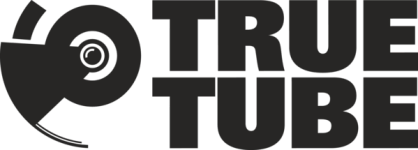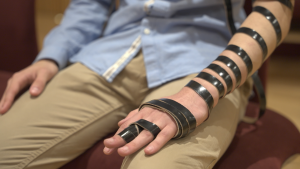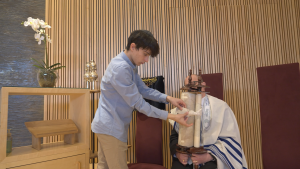Zack welcomes TrueTube to a North London Reform Synagogue for a tour of all its main features. Taking us from the door to the Ark, he talks about his beliefs and what happens during a service at the synagogue.
Curriculum Mapping
Holy Cribs: The Synagogue
Zack: Welcome to Alias Reformed Synagogue. My name is Zack. I'm Jewish, and my religion is called Judaism. This is where I come to worship. And it's often called a synagogue, which is a Greek word, meaning assembly, because this is where we all get together on the Shabbat, our holy day, which is on a Saturday. But Jewish people are more likely to call it a shul, which is a Yiddish word for school, or a Beit Knesset, which is Hebrew for House of gathering or Beit to Phila, which means House of Prayer or Beit Midrash, which means House of Learning. We have lots of different names for this building because it's used for lots of different things by the local community. In most schools, men are asked to cover their heads as a sign of respect for God. They usually wear a skullcap like this called a yarmuk or. Some shawls ask women to cover their heads as well. And in synagogues that would call themselves orthodox or conservative, married women cover their heads whenever they are outside the house with a hat, scarf or wig. Unmarried women often choose to cover their heads as well. This is the main room called the Sanctuary, where we have our services on the Shabbat. All synagogues are built to face the city of Jerusalem, where there used to be a huge temple. It was the center of Jewish life and people used to travel hundreds of miles to worship and celebrate festivals there. It was destroyed by the Romans nearly 2000 years ago, and only the Western Wall remains. So our synagogues are full of symbols and reminders of the temple we've lost. Orthodox and conservative Jews will separate men and women during services so that they are concentrating on worship rather than on each other. Women often sit upstairs in a gallery or balcony or downstairs in an area separated from the men by a barrier or screen called America. In a reformed synagogue like this, men and women sit together. Some Jews like to wear a special shawl called a tallit to pray. It can be quite difficult to get on because I've got to get this bit at the back has these fringes called Sits It, which represent the 613 Commandments in our holy book, which is called the Torah. And the Torah is kept in here. This is the Ark or our on Kadesh. It's the most important part of any synagogue because the Torah scrolls are kept in here when they're not being used in this jewel on the wall above the ark. We have some words from the Book of Psalms in Hebrew. Other schools will often have two plaques. These symbolize the original Ten Commandments, which were carved onto two stone tablets. According to the Torah. Moses brought them down from the top of Mount Sinai, where he was given the commandments by God. Here we have the first ten letters of the Hebrew alphabet to represent the Ten Commandments. There's also a lamp called the Tam ed, which means eternal light. And it's always lit to symbolize God's presence. Back in the day, it would have been an oil lamp. But these days it's usually electric. And the lamp in the temple would have looked like this, only much bigger. An oil lamp would seven branches called a menorah, and many shawls will have one. It's often used as a symbol for Judaism, but the star of David is probably the most common Jewish symbol. It's named after King David, the most famous Jewish king who killed a giant called Goliath when he was just a boy. We use these symbols to decorate our shores, and we might also use pictures or patterns of plants or trees. But you won't often find any pictures of people or animals. This is because we worship one God who cannot be seen, and so we won't usually have any pictures of God or anything that could be mistaken for God. During a service, the doors of the ark will be opened so that everyone can see the scrolls inside. In some shawls, there might be a curtain called a prophet over the doors. So that will be drawn back as well. The scrolls are treated with maximum respect like they're important people and are dressed when they're not being used. They're wrapped in a cloth cover called a mantle. A metal breastplate might be hung on the front to represent the breastplate that was worn by the temple priests in Jerusalem. And the walls are topped with decorations called nym, which means pomegranates because they're often made to look like pomegranates. People used to believe that there were 613 seeds in each pomegranate, one for each of the commandments in the Torah. During the service, one of the scrolls is chosen, undressed and carried over to a big reading desk on a raised area called a Bimmer. It's always at the front or the middle of the room so that everyone can hear the words of the Torah when they're being read out loud. Two scrolls are in Hebrew. They are written out by hand and made of natural materials. The scroll itself is made of animal skins, the ink from oil and charcoal and the rollers from wood. When we read the Torah, we follow the words with a pointer like this called a yard that so we don't damage the scroll with sweaty or greasy fingers. The word Yad means hand because the tip is often shaped to look like a hand with a pointy finger. Hebrew is read from right to left, the opposite direction to English. The rabbi will then give a sermon or talk about the reading. The word rabbi means teacher because that's their job to teach us about the Torah and how to live as Jews. The rabbi will often run midweek classes at the show and also spends a lot of time giving help and advice to the community. In Orthodox synagogues, the rabbi doesn't usually organize the service that's done by someone called a Hazan, which means singer because they lead the prayers and hymns in orthodox and conservative schools. The Rabbi and Hazan will always be men in reform schools. Both the Rabbi and Hazan can lead and organize the service in these synagogues. They can be men or women. At the end of the service, the scroll is wrapped up again and put back in the ark. There are lots of other rooms in the show that are used for all kinds of things during the week. Many people come here to ask for the rabbi's advice on things. There's a nursery of youth club and I come here to learn how to read Hebrew. Thanks for coming by.
Transcript
Holy Cribs: The Synagogue
Zack: Welcome to Alias Reformed Synagogue. My name is Zack. I'm Jewish, and my religion is called Judaism. This is where I come to worship. And it's often called a synagogue, which is a Greek word, meaning assembly, because this is where we all get together on the Shabbat, our holy day, which is on a Saturday. But Jewish people are more likely to call it a shul, which is a Yiddish word for school, or a Beit Knesset, which is Hebrew for House of gathering or Beit to Phila, which means House of Prayer or Beit Midrash, which means House of Learning. We have lots of different names for this building because it's used for lots of different things by the local community. In most schools, men are asked to cover their heads as a sign of respect for God. They usually wear a skullcap like this called a yarmuk or. Some shawls ask women to cover their heads as well. And in synagogues that would call themselves orthodox or conservative, married women cover their heads whenever they are outside the house with a hat, scarf or wig. Unmarried women often choose to cover their heads as well. This is the main room called the Sanctuary, where we have our services on the Shabbat. All synagogues are built to face the city of Jerusalem, where there used to be a huge temple. It was the center of Jewish life and people used to travel hundreds of miles to worship and celebrate festivals there. It was destroyed by the Romans nearly 2000 years ago, and only the Western Wall remains.
So our synagogues are full of symbols and reminders of the temple we've lost. Orthodox and conservative Jews will separate men and women during services so that they are concentrating on worship rather than on each other. Women often sit upstairs in a gallery or balcony or downstairs in an area separated from the men by a barrier or screen called America. In a reformed synagogue like this, men and women sit together. Some Jews like to wear a special shawl called a tallit to pray. It can be quite difficult to get on because I've got to get this bit at the back has these fringes called Sits It, which represent the 613 Commandments in our holy book, which is called the Torah. And the Torah is kept in here. This is the Ark or our on Kadesh. It's the most important part of any synagogue because the Torah scrolls are kept in here when they're not being used in this jewel on the wall above the ark. We have some words from the Book of Psalms in Hebrew. Other schools will often have two plaques. These symbolize the original Ten Commandments, which were carved onto two stone tablets. According to the Torah. Moses brought them down from the top of Mount Sinai, where he was given the commandments by God.
Here we have the first ten letters of the Hebrew alphabet to represent the Ten Commandments. There's also a lamp called the Tam ed, which means eternal light. And it's always lit to symbolize God's presence. Back in the day, it would have been an oil lamp. But these days it's usually electric. And the lamp in the temple would have looked like this, only much bigger. An oil lamp would seven branches called a menorah, and many shawls will have one. It's often used as a symbol for Judaism, but the star of David is probably the most common Jewish symbol. It's named after King David, the most famous Jewish king who killed a giant called Goliath when he was just a boy. We use these symbols to decorate our shores, and we might also use pictures or patterns of plants or trees. But you won't often find any pictures of people or animals. This is because we worship one God who cannot be seen, and so we won't usually have any pictures of God or anything that could be mistaken for God. During a service, the doors of the ark will be opened so that everyone can see the scrolls inside. In some shawls, there might be a curtain called a prophet over the doors. So that will be drawn back as well. The scrolls are treated with maximum respect like they're important people and are dressed when they're not being used.
They're wrapped in a cloth cover called a mantle. A metal breastplate might be hung on the front to represent the breastplate that was worn by the temple priests in Jerusalem. And the walls are topped with decorations called nym, which means pomegranates because they're often made to look like pomegranates. People used to believe that there were 613 seeds in each pomegranate, one for each of the commandments in the Torah. During the service, one of the scrolls is chosen, undressed and carried over to a big reading desk on a raised area called a Bimmer. It's always at the front or the middle of the room so that everyone can hear the words of the Torah when they're being read out loud. Two scrolls are in Hebrew. They are written out by hand and made of natural materials. The scroll itself is made of animal skins, the ink from oil and charcoal and the rollers from wood. When we read the Torah, we follow the words with a pointer like this called a yard that so we don't damage the scroll with sweaty or greasy fingers. The word Yad means hand because the tip is often shaped to look like a hand with a pointy finger. Hebrew is read from right to left, the opposite direction to English. The rabbi will then give a sermon or talk about the reading. The word rabbi means teacher because that's their job to teach us about the Torah and how to live as Jews. The rabbi will often run midweek classes at the show and also spends a lot of time giving help and advice to the community.
In Orthodox synagogues, the rabbi doesn't usually organize the service that's done by someone called a Hazan, which means singer because they lead the prayers and hymns in orthodox and conservative schools. The Rabbi and Hazan will always be men in reform schools. Both the Rabbi and Hazan can lead and organize the service in these synagogues. They can be men or women. At the end of the service, the scroll is wrapped up again and put back in the ark. There are lots of other rooms in the show that are used for all kinds of things during the week. Many people come here to ask for the rabbi's advice on things. There's a nursery of youth club and I come here to learn how to read Hebrew. Thanks for coming by.








